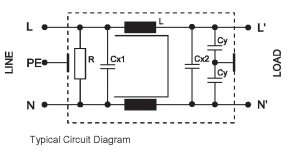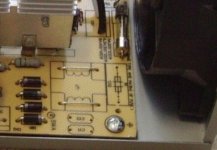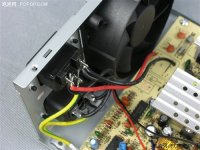However, I sure would like to know why there is no decent silicone sealer in Japan.
Have you tried this one?
????????? | Sika Ltd.
You mention "tube gear" ? Bad native PSRR ?DVV -And it is not a luxury in cramped urban areas, belive me, it has become a necessary evil, a need, especially if you own tube gear. Assuming a fair price, which is not in the peanut class, but has to stay below $1K and must be able to do its thing even with behemoths like offerings from Krell and Levinson.
We had this discussion in the solid state thread. The member was trying to filter
up to 100Mhz on his DC , with a great increase in the complexity of his PS.
This DC was powering a symmetric amp with known >1Mhz bandwidth.
I said this limited bandwidth ... plus the audio input R/C , would naturally negate
anything above 1mhz.
Still , I don't want to see it. It is cheap to use old PC filter common mode parts.
(below 1/2)
Just to show it - (below 3/4) , are the major culprits (cheap Asian knockoff supplies).
Believe it or not , those were UL listed and in OEM PC's. You think an
unfiltered CFL is bad ..... plug in one of those 300W units.
My Corsair 600W unit has 2 C/L/C's in series. You get what you pay for.
OS
Attachments
A good engineer will tell you 4% line noise on AC isn't worth blinking an eye at. .
A good engineer will design to the EMC/EMI specs that purport to the equipment with a decent margin.
Yes LED lamps could be EMI-quiet but I don't know of any that are.
Let us hope that the physiological effects of the greatly-increased levels of RF almost everywhere are not as bad as some alarmists claim. But I recall Casandra was right.
Nope, most of the LED replacements are the cheap ones , no L6561 PFC
correction IC like the more expensive CREE.
- Some will use just a cheap switching convertor , or even just a resistor with
paralleled LED's.
PS - at least the resistor will be "quiet". 😀
OS
OS
Actually, Coldhead, normal surge protectors like MOV's can actually DEGRADE the sound quality of a good audio system. That is why we chose Gas filled tube protectors instead. Much more linear. See, I just gave away a 'proven' design secret. '-)
Oh what a disgusting piece of it. Something that is designed to clip is more
linear than sth. else that is designed to clip.
I sometimes wonder if you really believe this drivel or if you use it only as a
marketing ploy. But one outcome is as bad the other.
But maybe there is only a script continuously bubbling up the same empty phrases,
and, sadly enough, that carries some hope.
I have seen the source code of an Eliza-like program. I'd estimate that its
author could write a famous audio designer in a week or two.
I sometimes wonder if you really believe this drivel or if you use it only as a marketing ploy. But one outcome is as bad the other.
More like somebody trying desperately to prove he can still be relevant and still make a difference.
- Some will use just a cheap switching convertor , or even just a resistor with
paralleled LED's.
PS - at least the resistor will be "quiet". 😀
In my lab, I can watch the energy saving lamps wobbling continuously between
50 and 60 KHz, or so depending on type. On a real time spectrum analyzer you
can see the peaks always floating around. LEDs are somewhat better behaved
than gas discharge lamps.
I'll probably return to halogen, at least in the lab.
regards, Gerhard
emtoColdhead, what kind of education do you think that I have? I have a degree in Physics with a minor in electrical engineering, as well as years of extra courses in electronic design (to fill in) from UC Berkeley, etc. Then again, 50 years of design experience on top of that. I just happen to be especially good at audio design, because I like it, and I keep an open mind, but I have been a SR Electronics Engineer at a company of 300 people doing medical electronics in the past. What do you want?
Respect for electronic engineers job, and knowledge. As ansver. 🙂
I had a strange feeling about recognising some animosity, femtoanimosity, but i couldn't even guess that is physicist behind audio designer.
My distant feeling seems to be correct.
I work at Institute of physcs(from 1984.), as a electrical engineer advisor(last 13 years in "european lab of exelence for nonequilibrium plasma"), diy audio is only hoby, but i recognized well known feeling of misunderstanding relation phucist vs e-ingeneer... 🙂
I respect open mind at every part of life, but discussion about dielectric ptfe vs fr4 for audio is not step up in upgrading audio electronic circuit, and audio design.
Open mind can notice invisible details, but open mind has to define meaningfulness of those details.
More like somebody trying desperately to prove he can still be relevant and still make a difference.
It's not that there had be no interesting themes waiting for a developer
in the last 40 years.
But not just p & n diff stage, folded cascode... as someone pointed out here recently.
I have read that MOV leakage current causes noise, GDTs do not.
Dan.
You mean, having a much sharper corner, they are much more effective
in creating overtones? So let's hope that the overtone distribution is euphonic.
Could well be you have data transmission on the power line causing your problem. I had a terrible time in Taiwan at the one house I stayed at and now surmise that this was the cause - but as to the source, I have no clue.
That's my best theory as well. It is semi-synchronized to the line frequency, with little "details" going on in certain sub-periods.
My only experience with gas discharge has been in telco, where they can be a royal pain in the butt as 100W@2GHz is enough to keep them arcing in many cases. Luckily in Europe a 1/4 wave stub is good enough but it seems that not only do people want to live in florida but they want mobile phones as well. Dashed poor form to do that somewhere where a lightning strike is guaranteed.
For domestic audio I would have thought that they were just too slow to actually protect anything. Quick check would suggest this is the case, although of course a paper from a company trying to sell surge protection does need the usual pinch of condiment http://www.littelfuse.com/~/media/e...plication_notes/gas_discharge_tubes/ec640.pdf
For domestic audio I would have thought that they were just too slow to actually protect anything. Quick check would suggest this is the case, although of course a paper from a company trying to sell surge protection does need the usual pinch of condiment http://www.littelfuse.com/~/media/e...plication_notes/gas_discharge_tubes/ec640.pdf
You mean, having a much sharper corner, they are much more effective
in creating overtones? So let's hope that the overtone distribution is euphonic.
Corners are sharp in the old ZnO devices. SiC MOVs have much softer corners.
You mean, having a much sharper corner, they are much more effective
in creating overtones? So let's hope that the overtone distribution is euphonic.
?? How could overtones of AC line current or line-borne transients be euphonic? They aren't related to the music programme are they? (Or maybe I missed a sarcasm hint?)
Actually, Coldhead, normal surge protectors like MOV's can actually DEGRADE the sound quality of a good audio system. That is why we chose Gas filled tube protectors instead. Much more linear. See, I just gave away a 'proven' design secret. '-)
It isn't easy to make a line filter that does not change the sound in a negative way. Many people just note a change, but others note what sort of change.
GDT is not "much more linear", it is simple avalanhe effect in ionized gas, forming plasma with her negative resistance..
Btw GDT are light sensitive, or radiation sensitive, and can incidently lower the trigger voltage. GDT is ideal for medical eguipment to protect patient of electrical shock, static or from equipment...
GDT low capacitance is useless at main line in paralel with Y capacitors, or X2...
MOV is with lower energy storage, and ocasionaly "eat" spikes and overvoltage at predetermined energy levels.
Also is possible to use zenamic transient supressors, or SADs..
Line filter is line filter, and could work good, or less good, better is double pole filter than single pole, but could not change sound in a bad way.
Corners are sharp in the old ZnO devices. SiC MOVs have much softer corners.
So what? that little bit of diverted current does not come closer to the HiFi than
2 meters or so, and the voltages that trigger them do not happen every 50/60 Hz
period. Maybe if the fridge switches off or in events like that. The MOVs don't
have the habit of melting on a daily base.
Those that feel that this can be heard should seriously question their ability
to design electronic stuff. I mean, if someone cannot produce a clean DC voltage
no matter what the input power is: should we expect audio highlights from him?
regards, Gerhard.
PS
It's cold outside, and we nearly have June. I want that snowman Smiley NOW.

My experience so far has been that power line noise problems are more effectively dealt with by treating them as ground loop problems. Waveforms on the power lines don't belong in the audio signal whether they are nice "clean" 60Hz sinusoids or MOV chopped up peaks or SCR transients. Decent balanced cable systems, transformer or InGenius isolators, doulble insulated supplues, or input stages with ground loop isolating properties seem a way more practical approach thgan providing cleaner AC hum to ride on the interconnected shields!
(in my so-far only blog here, I go through and analyze a way to configure inputs to reject ground noise.... not news to many here, but the analysis lit a few bulbs in my brain)
(in my so-far only blog here, I go through and analyze a way to configure inputs to reject ground noise.... not news to many here, but the analysis lit a few bulbs in my brain)
- Status
- Not open for further replies.
- Home
- Member Areas
- The Lounge
- John Curl's Blowtorch preamplifier part II



